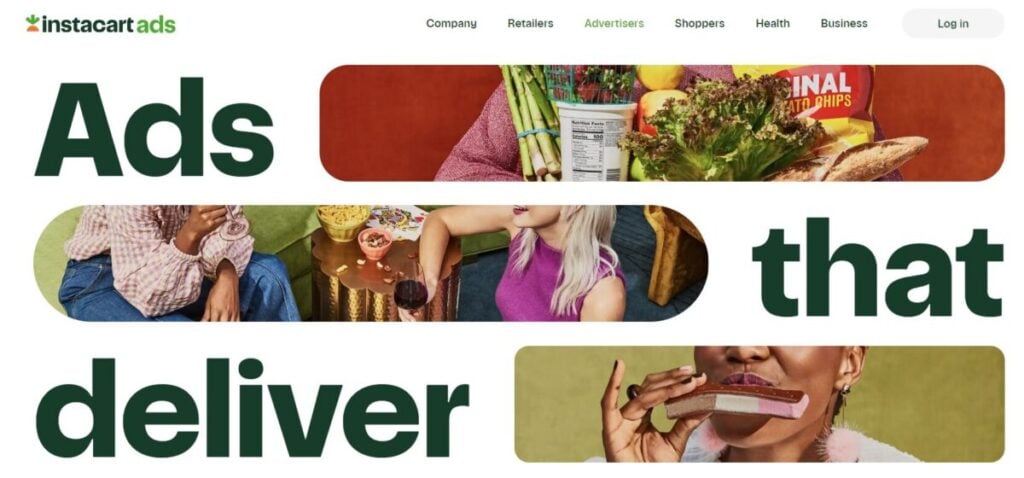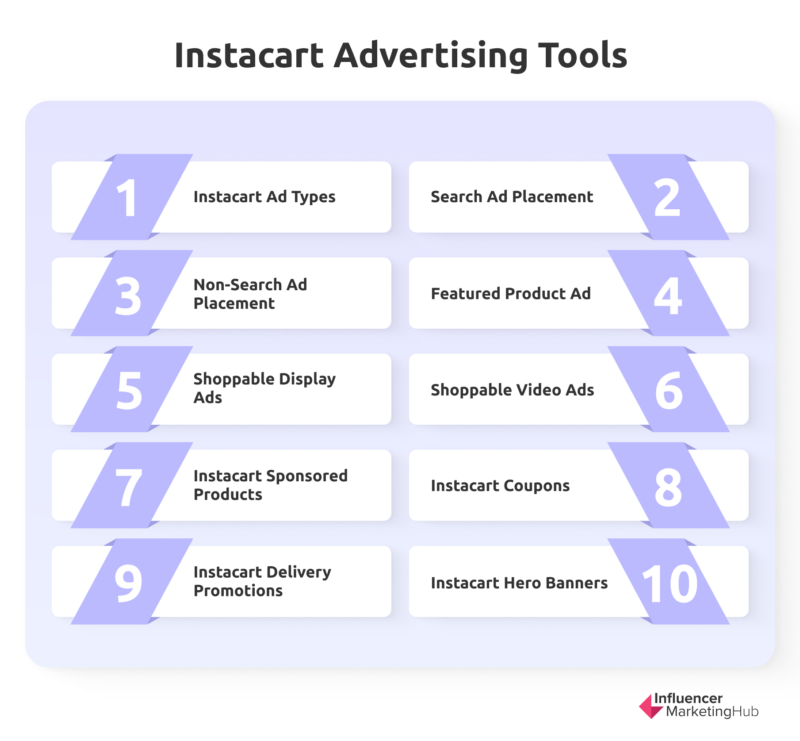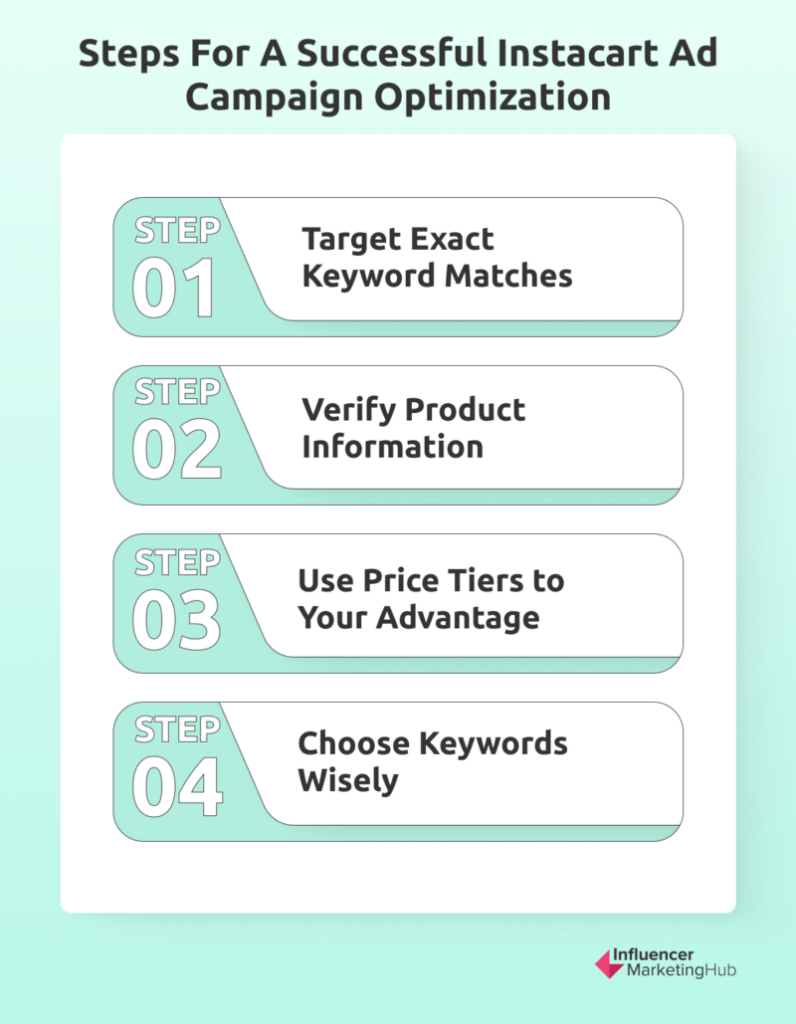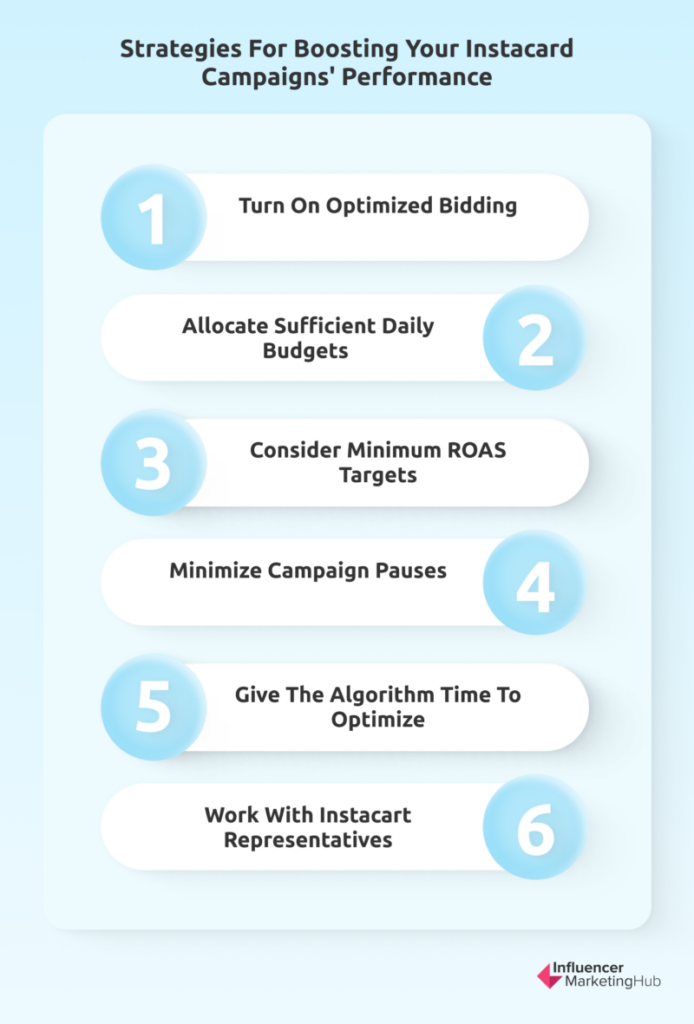Imagine the convenience of being able to do your grocery shopping from the comfort of your own home, without the hassle of navigating crowded aisles and long checkout lines. This is the reality for millions of consumers who have turned to online grocery shopping, and the numbers only continue to grow. The online grocery market is estimated to reach $65.51 billion in sales by 2031 in the US alone, with Instacart being a major player in this space. With over 14 million active users, Instacart has solidified its place as a leader in connecting consumers with their favorite grocery retailers through an easy-to-use digital platform.
Instacart’s platform provides brands with an incredible opportunity to reach highly engaged shoppers right at the point of purchase. Brands can now connect with consumers in meaningful ways, offering targeted promotions and relevant product placements that drive visibility and sales. As more consumers turn to online grocery shopping for convenience, Instacart advertising has become a valuable tool for brands to maximize their reach and influence in this rapidly growing market.
Let's take a closer look at Instacart advertising – the platform that's shaking up the grocery game and giving brands a new way to reach their customers. What exactly is Instacart advertising, and how can brands make the most of this platform? We're about to find out.
- What is Instacart Advertising?
- How does Instacart Advertising Work?
- Getting Started with Instacart Advertising
- Crafting the Perfect Instacart Campaign Structure
- Step-by-Step Guide on How to Optimize your Instacart Campaign
- Instacart Advertising: How to Boost Your Campaigns' Performance
- Frequently Asked Questions
What is Instacart Advertising?
Instacart Advertising is a self-service platform that enables brands to reach Instacart's vast customer base with targeted ads. Similar to other popular advertising platforms, such as Amazon, Instacart Advertising offers a range of features and tools to help brands achieve their advertising goals.

At its core, Instacart advertising is a way for brands to promote their products directly to customers on the Instacart platform. With a marketplace spanning more than 85,000 brick and mortar stores across more than 14,000 cities in the US and Canada, Instacart is a one-stop-shop for busy families and individuals who want to explore the largest grocery catalog in the world.
But what sets Instacart advertising apart from other forms of digital advertising is its unique approach. Unlike traditional online ads, which can be easily ignored or blocked by users, Instacart ads are seamlessly integrated into the platform, appearing as users browse and add items to their cart.
One of the major benefits of Instacart advertising is the ability to target specific customers based on their shopping habits and preferences. With Instacart's vast collection of first-party consumer data, brands can create highly customized campaigns that reach the right audience at the right time.
Another advantage of Instacart advertising is its flexibility. Brands can set their own budgets and bidding strategies, and only pay when users engage with their products. This means that even smaller brands with limited budgets can effectively compete with larger companies, and see real results from their campaigns.
But it's not just about getting your products in front of customers - Instacart advertising also offers valuable insights and analytics to help brands optimize their campaigns and measure success. Through the Customer Insights portal, brands can track performance metrics, compare themselves to competitors, and get a better understanding of what works and what doesn't.
So, how can brands make the most of Instacart advertising? It all starts with a solid strategy. Brands should focus on creating highly targeted campaigns that speak to the specific needs and preferences of their target audience. They should also take advantage of the platform's performance tracking tools to continually refine and optimize their campaigns for maximum impact.
How does Instacart Advertising Work?
Instacart users typically go to the platform to buy specific products, and they begin their shopping journey by inputting their location to view the supported retailers closest to them. They then select the retailer for pick-up or delivery and begin shopping for specific products. Unlike other major online retailers, such as Amazon, Instacart customers typically come to the platform with a specific intent to buy, not just to ‘look around’.
Getting Started with Instacart Advertising
Just like how a grocery store offers a variety of promotions to attract customers, Instacart offers multiple advertising options to help brands stand out and attract shoppers. While the primary focus of Instacart's self-service platform is sponsored products, the company provides a range of additional advertising tools to help brands effectively showcase their products and generate customer interest. These tools include Instacart Coupons, Instacart Delivery Promotions, and Instacart Hero Banners, which act as eye-catching visual displays that can be placed on category pages to promote featured products. These advertising tools are designed to mimic the effectiveness of in-store promotions, catching customers' attention and driving sales. Moreover, you can take advantage of third-party Instacart advertising software.

1. Instacart Ad Types
Instacart advertising presents a viable solution to the challenge of capturing the attention of potential customers in a saturated market by introducing a variety of ad formats.
Instacart Ads come in different shapes and sizes, each designed to reach customers in different ways.
2. Search Ad Placement
You know how customers quickly scan the top shelves of the grocery store for their preferred brands, well the same way Instacart prioritizes the first rows of the search results page. So, it’s obviously essential for brands to make their mark in these prime spots, and the way to do that is via Search Ad Placement. This type of ad allows brands to get in front of consumers who are already interested in their products, making it a highly targeted and effective advertising strategy.
To ensure the highest visibility, brands can bid on specific keywords that relate to their products. When a customer searches for that keyword, the sponsored product ads appear at the top of the search results page, making them more visible to potential customers.
3. Non-Search Ad Placement
These ads can appear on the home page, departments, item pages, and even in a customer's "Buy It Again" section, where past purchases are displayed. It's like putting your products in the best aisles in the grocery store to catch customers' attention.
4. Featured Product Ad
Instacart's self-serve marketing option is the Featured Product Ad. Similar to sponsored product placements on Amazon or Walmart, these ads are marked by a "featured" banner on the item's thumbnail. Brands can choose between two targeting options, auto and manual, to customize their campaigns. The auto-targeted ads allow Instacart's algorithm to decide which category pages are most relevant to the brand's products. On the other hand, manual-targeted ads require bidding on specific keywords based on the brand's level of competition.
5. Shoppable Display Ads
One of its most recent additions is shoppable display ads, which allow brands to reach the right consumer at the right time without disrupting the shopping experience. These ad units consist of a creative image along with a carousel of pinned products with direct add-to-cart functionality. Shoppable display ads not only make it easy for consumers to add pinned products to their cart but also provide a customized landing page where they can explore more of the brand's products.
6. Shoppable Video Ads
Another type of Instacart ad that has recently gained popularity is shoppable video ads. Unlike traditional video ads, shoppable video ads feature add-to-cart buttons directly on the ad itself and allow brands to flex their creativity and storytelling muscles with short, engaging videos. With Instacart's shoppable video ads, customers can easily add products featured in the videos to their cart and check out in as little as an hour. Shoppable video ads can be anywhere from 3 seconds to 30 seconds maximum. Brands can set up shoppable video ads using Instacart's enhanced campaign creation flows designed to help them achieve their marketing objectives.
7. Instacart Sponsored Products
This is the main type of ad that most brands deal with in Instacart. It deals directly with keyword targeting and is paid for in a self-service CPC format, with no minimum budget required. Sponsored products show up on the other side of search queries that a customer makes on Instacart, and visibility is based on retailer inventory and geographic availability. These sponsored products appear at the top of search results, and are a great way to gain instant visibility to in-market customers. Same as in a real grocery store, favorable product placement plays a significant role in product consideration.
8. Instacart Coupons
The best way for brands to incentivize customers to purchase their products, is by offering them coupons. This advertising tool can be used in two ways: by providing a percentage off the total cost of the item, or by providing a flat discount, such as $5 off the total cost of the item. Instacart Coupons can be targeted to a specific audience or set to be available to all customers. Once a coupon is redeemed, it won't be available for 30 days, and you only pay for coupons that are redeemed. Brands can book this promotion directly with Instacart representatives.
9. Instacart Delivery Promotions
Brands can leverage free delivery as another type of promotion, but it requires significant investment, along with inventory and distribution specifications, as it's organized at the enterprise level. Once again, this is a type of promotion that also books directly with Instacart representatives. However, note that these delivery promotions can be overwritten by Instacart-wide delivery promotions, so that’s something brands should keep in mind.
10. Instacart Hero Banners
Hero banners are the shining knights of Instacart's advertising realm, gallantly drawing customers' attention to a brand on some of the most prominent areas of the platform. With these banners, brands can bask in the spotlight atop coveted product sections like "Beverages", capturing the attention of shoppers with stunning visuals and compelling calls to action. These banners have a minimum flight date, ensuring sustained exposure to a targeted audience. To access this advertising option, brands can book directly with Instacart representatives.
Crafting the Perfect Instacart Campaign Structure
After exploring the various ad formats available on Instacart, let's focus on building a strong campaign structure that sets the stage for success. In this section, we'll discuss six essential components of a well-structured Instacart advertising campaign: Product Grouping, Budgeting, Bidding Options, Keyword Organization, Geo regions, and Tracking Performances.

1. Product Grouping
Organize your products into logical groupings, such as product categories or sub-brands, to create campaigns that are easier to manage, optimize, and pace. By doing so, you can quickly identify top-performing product segments and allocate resources more effectively.
2. Budgeting
Establishing a budget for your Instacart advertising campaign is crucial for maximizing results without overspending. Allocate your budget across campaigns, ad groups, and ad formats based on your objectives, target audience, and competitive landscape. Monitor your spending and adjust as needed to maintain optimal performance and cost efficiency.
3. Bidding Options
Instacart offers various bidding options to help you stay competitive and achieve your desired ad placements. Experiment with manual and automated bidding strategies, and adjust your bids based on the platform's recommendations and your performance data. By staying competitive with your bids, you can secure prime positions in search results and category pages, significantly increasing product visibility and driving more sales.
4. Keyword Organization
Effective keyword organization is key to a successful Instacart advertising campaign. Review and refine the default keywords provided by the platform, ensuring they are relevant and offer proper coverage. Group your keywords by product type, category, or theme to make your campaigns easier to manage and optimize. Remember, relevancy is crucial for a positive ecommerce shopping experience and higher conversion rates.
5. Geo regions
Targeting specific geographic regions is another critical component of a successful Instacart advertising campaign. By focusing on high-distribution regions, you can maximize your ad spend and increase the likelihood of driving sales. Keep retailer inventory and geographic availability in mind when planning your campaign, and adjust your targeting as needed based on performance data.
6. Tracking Performances
Monitor your campaign performance closely, gathering insights to optimize your advertising strategies. Regularly review your KPIs, such as click-through rate, conversion rate, and return on ad spend, and adjust your campaigns accordingly to maximize results. Embrace a data-driven approach to Instacart advertising and continually refine your strategies to stay ahead of the competition.
Step-by-Step Guide on How to Optimize your Instacart Campaign
Optimizing your Instacart marketing campaign can be the winning move that transforms your brand's performance. To help you achieve success, here's a step-by-step guide with key tips to keep in mind:

Step 1:
Target Exact Keyword Matches To ensure that your ads are showing up for the right audience, focus on search queries that perform well with exact keyword matches. Unlike other advertising platforms, Instacart only uses exact keyword matches, so it's crucial to concentrate on keywords that drive results.
Step 2:
Verify Product Information Before uploading your ads, ensure that your unique product codes (UPC), inventory, and item descriptions are correct and up to date. Outdated information can lead to confusion among customers and ultimately hurt your sales. Additionally, make sure that your product images are of high quality and reach out to Instacart if you notice any issues.
Step 3:
Use Price Tiers to Your Advantage Maximize your return on investment by setting higher bids on items with a higher average selling price (ASP). This optimization strategy can help you make the most out of your ad spend.
Step 4:
Choose Keywords Wisely Be careful with the keywords you add to your Instacart campaigns. Once added, these keywords cannot be paused and can only have their bids reduced to 15 cents. Therefore, it's crucial to choose your keywords wisely and bid strategically to avoid wasting your ad budget.
Note
With these tips in your back pocket, you'll be armed with the secret sauce to transform your Instacart campaigns from a mild salsa to a fiery, mouth-watering hot sauce that drives incredible results for your brand.
Instacart Advertising: How to Boost Your Campaigns' Performance
As competition increases in the digital advertising space, it's essential to optimize your Instacart campaigns to ensure your brand stands out and reaches your target audience effectively. Instacart offers various advertising options for brands, including sponsored product ads, shoppable display ads, and shoppable video ads. To maximize the performance of your Instacart campaigns, it's crucial to optimize them with the following strategies:

1. Turn on Optimized Bidding
By switching from manual bidding to optimized bidding or creating new daily budget campaigns that use optimized bidding, you can automatically set the optimal bid for your campaigns to generate the largest possible expected sales revenue that your budget can afford. With optimized bidding enabled on your campaigns, you'll start to see the results for yourself.
2. Allocate Sufficient Daily Budgets for Your Campaigns
To take full advantage of optimized bidding, ensure your campaigns have a sufficient daily budget to capture the most sales value. We recommend starting with a daily budget higher than $20 a day to optimize your campaigns for the most sales. Additionally, campaigns with a daily budget higher than $100 will optimize faster for more sales.
3. Consider Minimum ROAS Targets
When optimizing your Instacart advertising campaign, you may want to set a minimum return on ad spend (ROAS) goal. Your minimum ROAS goal is not the same as your target ROAS, but rather the lowest possible ROAS you're willing to accept at the campaign level. By setting a conservative minimum ROAS goal, the algorithm can aim to achieve the highest ROAS possible while never going under your desired minimum. For best guidance and results, follow the minimum ROAS recommendations provided in Ads Manager.
4. Minimize Campaign Pauses
Frequently pausing campaigns during the day or dayparting can decrease the effectiveness of the predictions, reducing the benefits and performance of optimized bidding significantly. Instead of frequently pausing campaigns, allow the algorithms powering optimized bidding to take into account many factors and maximize your campaign auction participation throughout the day. By refraining from frequently pausing campaigns, you can help maintain the effectiveness and ensure optimized bidding performs at its best, resulting in improved benefits and performance.
5. Give the Algorithm Time to Optimize
Consider allowing sufficient time for the algorithm to optimize all aspects of your campaign and find the optimal bid, to ensure that it performs at its best. Give at least one week for the algorithm to optimize all aspects of your campaign and find the optimal bid. This allows the algorithm to adjust and optimize your campaigns for the best performance.
6. Working with Instacart Representatives to Optimize Campaigns
Working with your Instacart representative can help answer questions about optimized bidding, learn more about its impact on your campaigns, or walk through setting up optimized bidding on your campaigns.
Crafting a successful Instacart marketing campaign is a paramount step in carving a niche for your brand amidst the cut-throat competition. Strategic optimization of your campaigns is the key to ensuring that your brand reaches your target audience and attracts their attention. By embracing these invaluable tips, you can unlock the full potential of your Instacart campaigns and achieve remarkable returns on your advertising investment. Good luck!
Frequently Asked Questions
What is Instacart advertising?
Instacart advertising is a platform that allows brands to create targeted campaigns that appear in specific search results or guide the customer's shopping experience with banners and general ads on category pages.
What types of ads are available on Instacart?
There are several types of ads available on Instacart, including sponsored products, coupons, delivery promotions, and hero banners.
How does Instacart determine which ads to display?
Instacart uses an algorithm that takes into account factors such as bid amount, relevance, and customer behavior to determine which ads to display.
Can I track the performance of my Instacart ads?
Yes, Instacart provides several metrics to track the performance of your ads, including attribution, impressions, clickthrough rate (CTR), return on ad spend (RoAS), organic and total sales, and basket penetration.
How can I optimize my Instacart campaigns?
To optimize your Instacart campaigns, focus on targeting search queries with exact keyword matches, ensuring that your product information is correct and up-to-date, using price tiers to your advantage, and carefully selecting keywords and bidding strategically.
Can I get help with my Instacart advertising campaigns?
Yes, you can work with your Instacart representative to get help with your campaigns, learn more about the impact of optimized bidding, and set up your campaigns for success.


